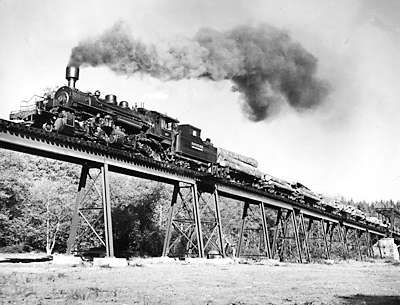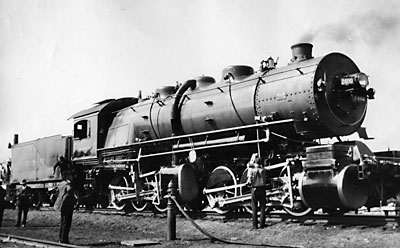A Mallet locomotive has two engines, which are independently mounted on an articulated frame. A high-pressure engine is located at the rear. Steam exhausted from it is conveyed forward to a low-pressure engine that is on the articulating part of the frame at the front of the locomotive.
Because exhausted steam from the rear engine has been partially expanded (and has a greater volume than high-pressure steam), the low-pressure cylinders of the front engine need to be much larger than those of the rear high-pressure engine.
The boiler is mounted so that roughly an equal amount of the locomotive’s weight is supported by each engine. This gives each about the same adhesion, and under normal operating conditions, the same power.
The Mallet was a slow-speed engine intended for use on mountain grades or on heavy drag freights. Its design, with the articulated frame, permitted a powerful locomotive to negotiate the often sinuous track found in mountainous territory.
The first Mallet of American design was an 0-6-6-0 built by Alco for the Baltimore & Ohio in 1904. The only one of its type on B&O’s roster, it was put to work as a helper on the railroad’s mountain grades west of Cumberland, Md.
Baltimore & Ohio was not the only railroad to quickly embrace articulated power. In 1906, Great Northern took delivery of five 2-6-6-2s for operation on its lines in the Cascade Mountains of Washington State. Built by Baldwin, they were the first locomotives with this wheel arrangement – a logical outgrowth of the 0-6-6-0. The two-wheel engine truck gave the engine better riding stability than an 0-6-6-0, and the two-wheel trailing truck helped support the weight of the firebox.
Many more 2-6-6-2s were built in the first decades of the 20th century, with successive locomotives incorporating various design improvements. After 1910, superheating became standard. The firebox was moved behind the rear driving wheels and supported by an outside bearing radial trailer truck. Combustion chambers were added. The locomotive grew in size.
Several railroads ordered 2-6-6-2s, including Chesapeake & Ohio, Norfolk & Western, Northern Pacific, Milwaukee Road, Western Pacific, Rio Grande, and Wheeling & Lake Erie.
Nevertheless, the 2-6-6-2 was a drag freight engine, not capable of speeds above 20 or 25 mph. As a result, its application was limited to low-speed, heavy-hauling tasks.
In 1909, three years after the 2-6-6-2 appeared, the 2-8-8-2 Mallet locomotive was introduced. Its subsequent evolution paralleled that of the 2-6-6-2. The 2-8-8-2 offered all the advantages of the 2-6-6-2, and also produced greater tractive effort.
Heavy freight assignments soon went to the bigger Mallet, or to large simple non-articulated engines that were then being developed. The 2-6-6-2 was then relegated to niche roles filling assignments for which it was best suited, such as mine runs.
After 1920, only Chesapeake & Ohio ordered new 2-6-6-2s. On other railroads, the type was obsolete. In 1949, Chessie received the final ten 2-6-6-2s built, which also happened to be Baldwin’s last U.S. steam locomotive delivery.
Overall, about 1,300 2-6-6-2 locomotives were built for use in North America.
One location where the 2-6-6-2 proved popular was in the woods. A number of western logging companies used both tender and tank versions to power log trains headed for its mills. These oil-burning engines were much smaller than their mainline cousins but were ideal timber haulers. Their high adhesion and articulated frames gave them the ability to handle sizeable trains over curving and lightly built track. Many of those locomotives lasted well into the diesel era.















